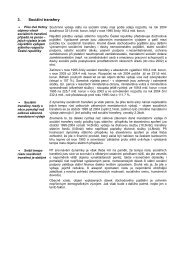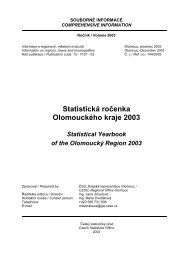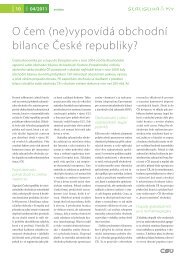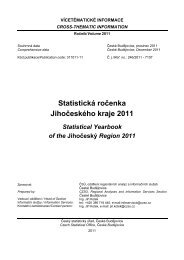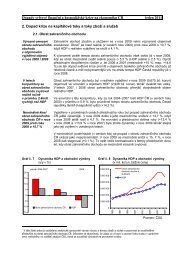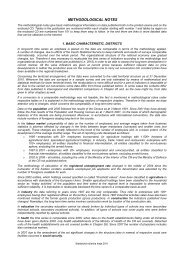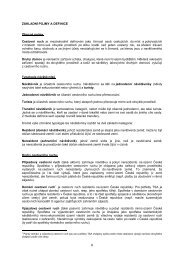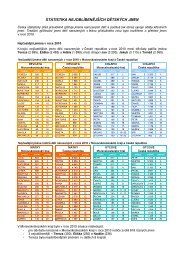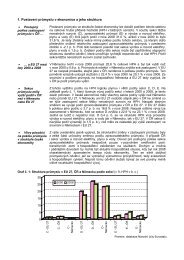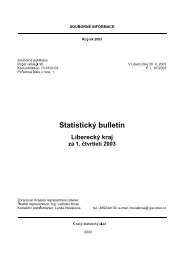Statistická ročenka Olomouckého kraje 2011 - Český statistický úřad
Statistická ročenka Olomouckého kraje 2011 - Český statistický úřad
Statistická ročenka Olomouckého kraje 2011 - Český statistický úřad
You also want an ePaper? Increase the reach of your titles
YUMPU automatically turns print PDFs into web optimized ePapers that Google loves.
Building permit means the building permit issued according to Section 115 of the Construction Act with binding terms<br />
and conditions for the implementation and usage of the construction. Building notification means the permit for simple<br />
constructions pursuant to Section 104 paragraph 2 a) to d) of the Construction Act. The approximate value of<br />
constructions involves total costs, including technologies (at current prices) incurred for the preparation,<br />
implementation, and putting of the construction into operation. Environmental protection structures mean<br />
constructions for protection of water, soil, and climate, for air pollution control, nature conservation, for environmentally<br />
friendly waste management, and to reduce environmental impacts of physical factors.<br />
Data on housing construction include construction of new dwellings on the given territory by means of all types of<br />
construction activities. The dwelling shall mean one room or a set of rooms designed for living by the planning and<br />
building control authority decisions and can serve the purpose as independent dwelling units. Dwellings started are<br />
since 2006 dwellings in buildings which construction was permitted in the reference period by building permits have been<br />
granted. Since 2007 these shall mean dwellings construction of which commenced on the basis of building permit<br />
granted or building notifications. It does not matter whether they were completed in the reference period or not.<br />
Dwellings completed are dwellings, for which the competent planning and building control authorities issued approvals<br />
pursuant to the Construction Act, as amended by the end of the reference period.<br />
The living floor area of the dwelling is the floor area of habitable rooms. The habitable room is a directly natural light<br />
illuminated and ventilated room of at least 8 m 2 of floor area, which can be sufficiently heated, directly or indirectly, and<br />
which is designed and equipped for the year-round dwelling. The living floor area includes neither areas of ancillary<br />
rooms (as an entrance hall, for instance) nor facilities (as a toilet and bathroom, for instance). The useful floor area of<br />
the dwelling means the area of all habitable and ancillary rooms, including facilities of the dwelling.<br />
16. TOURISM<br />
Tourism statistics includes data on capacity and outputs of collective tourist accommodation establishments and also<br />
data from sample survey among households on travel behaviour of residents. Besides data by region and district, also<br />
data on tourist areas and tourist regions are published. These areas were officially determined by the CzechTourism<br />
agency in 2005.<br />
Collective accommodation establishments mean establishments with at least five rooms or ten beds that on a regular<br />
(or irregular) basis provide tourists (including children) with temporary accommodation for the purpose of vacations, trip,<br />
spa treatment, business trip, training, course, congress, symposium, stay of children at schools in nature, summer and<br />
winter children camps. They are divided by category determining the type of accommodation establishment and the class<br />
defining requirements for the equipment, level, and range of services connected with the accommodation. The collective<br />
accommodation establishments include hotels, boarding houses, hostels, holiday dwellings, camp-sites, and other<br />
accommodation establishments.<br />
Bed places in accommodation establishments mean all permanent beds used for the overnight rest of guests (excluding<br />
extra beds). Places for tents and caravans mean the number of places for tents, caravans, and campers.<br />
Guests in an accommodation establishment are all persons (including children and excluding owners and operating<br />
personnel of the accommodation establishment) who have used services of the accommodation establishment for their<br />
temporary stay. Persons, who use an accommodation establishment for a temporary stay for the purpose of employment<br />
or full-time studies, are not included. The length of a temporary stay shall not exceed 1 year for the guest to be taken as<br />
a tourist. A person with a permanent stay in the Czech Republic is considered a resident. It can therefore be a citizen of<br />
the Czech Republic as well as a foreign citizen permanently living in the Czech Republic. A non-resident is hence<br />
a person, who permanently lives in other country (including citizens of the Czech Republic permanently living abroad).<br />
The average length of stay is by one day longer than the average number of overnight stays. The net occupancy rate<br />
of bed places gives the net occupancy rate of permanent beds that were really available to guests. The calculation is<br />
based on the average number of available beds and the number of operating days of the accommodation establishment.<br />
The occupancy rate of rooms gives the net occupancy rate of rooms. The calculation is based on the number of<br />
implemented room-days (i.e. the total number of days, for which the room was occupied by at least one guest) and the<br />
total number of room-days.<br />
The Tourism Sample Survey (TSS) carried out in the Czech Republic monthly is the source of data on long and short<br />
foreign as well domestic trips (yet data on foreign trips are not sufficiently representative at the regional level). The<br />
survey is based on a two-stage random sample in a sample of dwellings of sampled census districts. Members of a<br />
household are asked about trips they made in the last three months for the purpose of spending leisure time and<br />
recreation or a business trip out of their usual environment (permanent or temporary residence, workplace, school, etc.).<br />
Before 2009, data were surveyed at one randomly selected household member aged 15+ years, in 2009 among all<br />
household members aged 15+ years, and since 2010 involvement of all household members is surveyed regardless of<br />
their age. The data ascertained in this manner are then grossed up to the whole population using mathematical and<br />
statistical methods.<br />
A long trip means a trip taken for the purpose of spending leisure time and recreation, in which the person stayed over<br />
night at least four times in succession out of their usual environment. A short trip means a trip taken for the purpose of<br />
spending leisure time and recreation, in which the person stayed over night, at least once, but no more than three times<br />
in succession, out of their usual environment (weekend stays included).<br />
Expenditure on short and long trips include expenditure on the trip, on accommodation out of the trip (incl. board<br />
included in the price of accommodation), on meals out of the trip, expenditure on transport out of the trip, purchase of<br />
<strong>Statistická</strong> <strong>ročenka</strong> <strong>Olomouckého</strong> <strong>kraje</strong> <strong>2011</strong> 199



